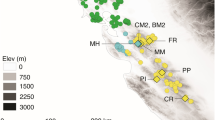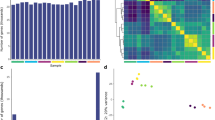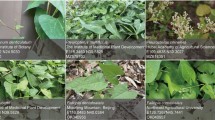Abstract
The flowers of Clarkia gracilis subsp. sonomensis have large petals each with a large, central, red-purple spot while the flowers of subsp. gracilis are small and unspotted. Other pigmentation (anthocyanin) patterns also vary within and between these subspecies. We carried out a genetic analysis of differences in floral patterns and petal size. A novel basal petal spot appeared in the F2. The analysis indicated that the novel petal spot was specified by an allele in subsp. gracilis at a locus governing spot position. This allele is not normally expressed in subsp. gracilis because of the action of a modifier gene at a second locus. The study also indicated single factor inheritance for presence versus absence of pigmentation on the hypanthium, stamens, and the lower portion of the petals. Multifactorial inheritance was observed for differences in petal length and width. Most of the possible recombinant floral patterns were recovered in the F2 and F3. This system can be used to study developmental regulation of floral traits as well as ecological relationships between floral pattern and pollination system. The recovery of a normally unexpressed allele for basal petal spot points to the difficulty of extrapolating from phenotypic analysis to an understanding of morphological evolution.
Similar content being viewed by others
Article PDF
References
Abdel-Hameed, F, and Snow, R. 1968. Cytogenetic studies in Clarkia, section primigenia IV. A cytological survey of Clarkia gracilis. Amer J Bot, 55, 1047–1054.
Abdel-Hameed, F, and Snow, R. 1972. The origin of the allotetraploid Clarkia gracilis. Evolution, 26, 74–83.
Cornu, A, and Maizonnier, D. 1983. The genetics of Petunia. Janick, J. (ed.). In Plant Breeding Reviews, 1, 11–58.
De Winton, D, and Haldane, J B S. 1933. The genetics of Primula sinensis. II. Segregation and interaction of factors in the diploid. J Genet, 27, 1–44.
Dorn, P S, and Bloom, W L. 1984. Anthocyanin variation in an introgressive complex in Clarkia. Biochem. Syst. Ecol, 12, 311–314.
Ennos, R A, and Clegg, M T. 1983. Flower color variation in the morning glory, Ipomoea purpurea J Hered., 74, 247–250.
Fincham, J R S, and Harrison, B J. 1967. Instability at the Pal locus in Antirrhinum majus. II. Multiple alleles produced by mutation of one original unstable allele. Heredity, 22, 211–224.
Gottlieb, L D. 1986. Genetic differentiation, speciation and phylogeny in Clarkia (Onagraceae). Iwatsuki, K., Raven, P. H. and Bock, W. J. (eds). In Modern Aspects of Species, University of Tokyo Press, Tokyo, pp. 145–160.
Gottlieb, L D, and Weeden, N F. 1979. Gene duplication and phylogeny in Clarkia. Evolution, 33, 1024–1039.
Harland, S C. 1929. The genetics of cotton. Part I. The inheritance of petal spot in new world cottons. J Genet, 20, 365–385.
Holsinger, K, and Gottlieb, L D. 1988. Isozyme variability in the tetraploid Clarkia gracilis (Onagraceae) and its diploid relatives. Syst Bot (In press.)
Hutchinson, J B. 1932. The genetics of cotton. Part VIII. The inheritance of anthocyanin pigmentation in Asiatic cottons. J Genet, 26, 317–339.
Imai, Y. 1931. Analysis of flower color in Pharbitis nil. J Genet, 24, 203–224.
Lewis, H. 1973. The origin of diploid neospecies in Clarkia. Amer Natur, 107, 161–170.
Lewis, H, and Lewis, M E. 1955. The genus Clarkia. Univ Calif Publ Bot, 20, 241–392.
Macswain, J W. Raven, P H, and Thorp, R W. 1973. Comparative behavior of bees and Onagraceae. IV. Clarkia bees of the western United States. Univ Calif Publ Entomology, 70, 1–80.
Moore, D M, and Lewis, H. 1965. The evolution of self-pollination in Clarkia xantiana. Evolution, 19, 104–114.
Philp, J. 1933. The genetics of Papaver rhoeas and related forms. J Genet, 28, 175–203.
Rasmuson, H. 1921. Beiträge zu einer genetischen Analyse zweier Godetia-Arten und ihrer Bastarde. Hereditas, 2, 143–289.
Riley, H P. 1945a. Inheritance of the main anthocyanin pigmentation and of some of its patterns in flowers of Nemesia strumosa. Bot Gaz, 107, 32–51.
Riley, H P. 1945b. Inheritance of orange and yellow flower color in Nemesia strumosa. Bull Ton Bot Club, 72, 435–453.
Riley, H P. 1948. The eyebrow gene in Nemesia strumosa. J Hered, 39, 170–172.
Riley, H P. 1949. Relationship of blue and orange flower color types in Nemesia strumosa. Bot Gaz, 111, 43–52.
Sokal, R R, and Rholf, F J. 1981. Biometry, 2nd ed., W. H. Freeman and Co., San Francisco, CA.
Soltis, P S. 1986. Anthocyanidin variation in Clarkia (Onagraceae). Biochem Syst Ecol, 14, 487–489.
Sytsma, K, and Gottlieb, L D. 1986a. Chloroplast DNA evidence and phylogenetic relationships in Clarkia sect. peripetasma (Onagraceae). Evolution, 40, 1248–1261.
Sytsma, K, and Gottlieb, L D. 1986b. Chloroplast DNA evidence for the origin of the genus Heterogaura from a species of Clarkia (Onagraceae). Proc Natl Acad Sci USA, 83, 5554–5557.
Author information
Authors and Affiliations
Rights and permissions
About this article
Cite this article
Gottlieb, L., Ford, V. Genetic studies of the pattern of floral pigmentation in Clarkia gracilis. Heredity 60, 237–246 (1988). https://doi.org/10.1038/hdy.1988.37
Received:
Issue date:
DOI: https://doi.org/10.1038/hdy.1988.37
This article is cited by
-
Two genetic changes in cis-regulatory elements caused evolution of petal spot position in Clarkia
Nature Plants (2018)
-
Joining the dots
Nature Plants (2018)
-
Genetics of floral traits of Jaltomata procumbens (Solanaceae)
Brittonia (2017)
-
The influence of pigmentation patterning on bumblebee foraging from flowers of Antirrhinum majus
Naturwissenschaften (2013)
-
Upper petal lip colour polymorphism in Collinsia heterophylla (Plantaginaceae): genetic basis within a population and its use as a genetic marker
Journal of Genetics (2009)



